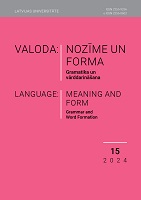Spāņu valodas dzimtes kategorija etnolingvistiskā un sociolingvistiskā aspektā
Ethnolinguistic and sociolinguistic aspects of the gender category in Spanish
Author(s): Alla PlacinskaSubject(s): Language studies, Gender Studies, Sociology, Sociolinguistics
Published by: Latvijas Universitātes Akadēmiskais apgāds
Keywords: gender; sex; meaning; form; discrimination; inclusive language;
Summary/Abstract: The study examines the creation and development of the grammatical category of gender in the Spanish language, its definition and application, as well as cultural and historical circumstances that have influenced these processes. The particular interest in the gender category is due to the sociolinguistic polemics among the modern Spanish society, mass media and linguists about the recommendations for inclusivity in using the language. The recommendations have been recently elaborated by linguists, as well as public and political institutions. In Spanish, there are two genders, feminine and masculine. There is no neuter, however, there are some common gender nouns. The representatives of feminism insist language is discriminatory towards women because the male gender forms denote both male and biologically unmarked nouns used to denote people collectively. The advocates of the inclusive language demand that the use of the unmarked gender be abandoned, replacing it with other forms. One of the most radical suggestions is to introduce the third gender. It is proposed to be made by adding the ending -e (-es in plural) and derived from the nouns already existing in the two gender forms, such as: maestro, maestra, maestre. At the terminology level, binom sexo/género (sex/gender in English) and the linguistic use of these terms raise interest. The results of the study lead to the conclusion that the language already is non-discriminatory and contains grammatical forms for describing gender neutrality. The claim that male dominance in society dictates their dominant role in language has not been substantiated by scientific evidence. Discrimination against women is a societal problem that has also found its reflection in language, mostly at the lexical level. The guidelines developed by several institutions for the implementation of inclusive language have not been supported by the Royal Academy of Spain and are described as efforts to create an artificial discourse.
Journal: Valoda: nozīme un forma
- Issue Year: 2024
- Issue No: 15
- Page Range: 152-171
- Page Count: 20
- Language: Latvian

